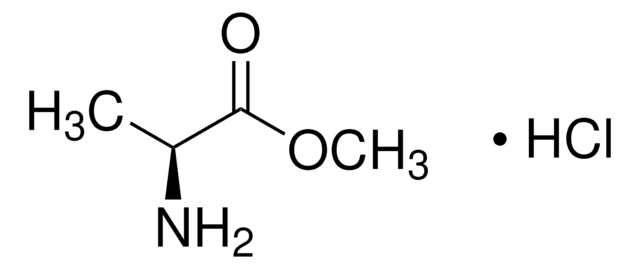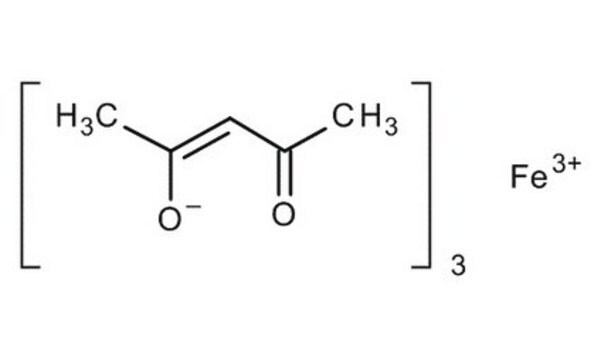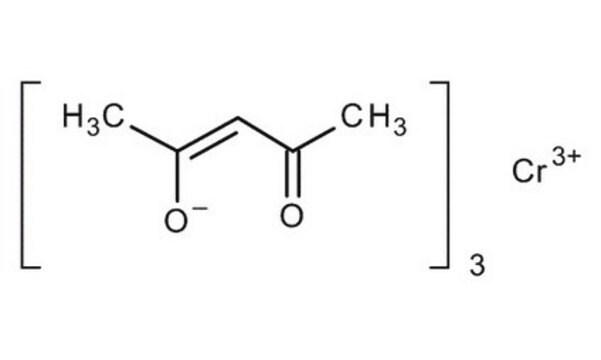517003
Iron(III) acetylacetonate
≥99.9% trace metals basis
Sinónimos:
2,4-Pentanedione iron(III) derivative, Fe(acac)3, Ferric acetylacetonate, Iron(III) 2,4-pentanedionate
About This Item
Productos recomendados
assay
≥99.9% trace metals basis
form
powder
reaction suitability
core: iron
reagent type: catalyst
mp
180-182 °C (dec.) (lit.)
density
5.24 g/mL at 25 °C (lit.)
SMILES string
CC(=O)\C=C(\C)O[Fe](O\C(C)=C/C(C)=O)O\C(C)=C/C(C)=O
InChI
1S/3C5H8O2.Fe/c3*1-4(6)3-5(2)7;/h3*3,6H,1-2H3;/q;;;+3/p-3/b3*4-3-;
InChI key
AQBLLJNPHDIAPN-LNTINUHCSA-K
¿Está buscando productos similares? Visita Guía de comparación de productos
General description
Application
- A iron precursor for the synthesis of Fe3O4/carbon composite fibers via forcespinning technique. This composite material used in the formation of high-performance anode materials for lithium-ion batteries.
- A precursor for the synthesis of iron-containing metal-organic frameworks (MOFs) for the applications in rechargeable alkali-ion batteries.
- An additive to enhance the efficiency of the N-hydroxyphthalimide (NHPI) catalyst in the oxidation of cumene.
- A solvent activation agent in the fabrication of polyamide membranes, which are used in reverse osmosis (RO) applications.
- As a MOCVD precursor for highly crystalline (Zn,Fe)Fe2O4 films and magnetic property measurements of these films. Iron (III) acetylacetonate may be used as a precursor for the synthesis of water-soluble magnetite nanoparticles, which may find applications in magnetic hyperthermia treatment.
- As a MOCVD precursor for highly crystalline (Zn,Fe)Fe2O4 films and magnetic property measurements of these films.
signalword
Danger
hcodes
Hazard Classifications
Acute Tox. 4 Dermal - Acute Tox. 4 Inhalation - Acute Tox. 4 Oral - Eye Dam. 1
Storage Class
11 - Combustible Solids
wgk_germany
WGK 3
flash_point_f
Not applicable
flash_point_c
Not applicable
ppe
dust mask type N95 (US), Eyeshields, Gloves
Elija entre una de las versiones más recientes:
¿Ya tiene este producto?
Encuentre la documentación para los productos que ha comprado recientemente en la Biblioteca de documentos.
Los clientes también vieron
Artículos
Solvothermal synthesis is a method for preparing a variety of materials such as metals, semiconductors, ceramics, and polymers.
Professor Randal Lee (University of Houston, USA) discusses design considerations for iron oxide magnetic nanospheres and nanocubes used for biosensing, including synthetic procedures, size, and shape. The effects of these variables are discussed for various volumetric-based and surface-based detection schemes.
Magnetic nanoparticles have attracted tremendous attention due to their novel properties and their potential applications in magnetic recording, magnetic energy storage and biomedicine.
Magnetism and magnetic materials have been of scientific interest for over 1,000 years. More recently, fundamental investigations have focused on exploring the various types of magnetic materials and understanding the magnetic effects created by electric currents.
Nuestro equipo de científicos tiene experiencia en todas las áreas de investigación: Ciencias de la vida, Ciencia de los materiales, Síntesis química, Cromatografía, Analítica y muchas otras.
Póngase en contacto con el Servicio técnico














